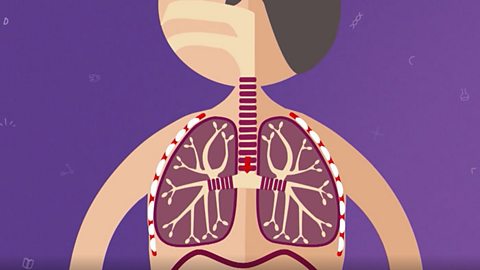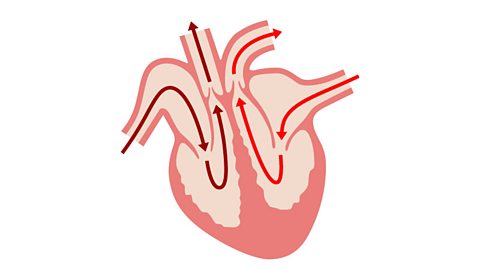Key points
Respiration is a chemical reaction which occurs in all living cells, releasing energy from glucose.
Aerobic respiration occurs with oxygen and releases more energy but more slowly.
Anaerobic respiration occurs without oxygen and releases less energy but more quickly.
Understanding respiration
Video
VOICEOVER: Understanding respiration. Do not confuse respiration with breathing or to use the scientific name, ventilation. Respiration is a chemical reaction. It occurs in all plant and animal cells. During this reaction, energy from glucose is released. This energy enables organisms to live. Aerobic respiration requires oxygen. Carbon dioxide is produced as a by-product and we show this using the word equation: glucose plus oxygen, produces carbon dioxide and water. Aerobic respiration produces energy, much more efficiently than anaerobic respiration, but is a slower process. Anaerobic respiration does not require oxygen. Lactic acid is produced as a by-product. We show this using the word equation: glucose produces lactic acid. Anaerobic respiration produces much less energy than aerobic respiration, but it is a much faster process.
Katie: OK, so, let's expand on what we've just heard, shall we?
Dr. Tim: Alright, Katie. So what we've already learned is that respiration is not the same as breathing - it's a chemical reaction and it occurs in all living cells, all of the time, and his energy that's released from glucose. Now, there are two types of respiration. Over to you, Katie.
Katie: OK. It's aerobic and anaerobic, but what's the difference between them?
Dr. Tim: Perfect. So if we look at these two types of respiration as an equation, it'll help us to understand better. Aerobic respiration occurs in the presence of lots of oxygen, like if we were running a marathon or something like that. And the equation that represents this reaction is glucose plus oxygen gives carbon dioxide, plus water. This is the process of releasing energy from glucose in the presence of oxygen, which occurs in all living cells.
Katie: OK, great. And what about anaerobic respiration?
Dr. Tim: So, anaerobic respiration is a little bit different because it occurs when there is not sufficient oxygen, as if we're doing a mad 100m sprint or something like that. And the equation that represents anaerobic respiration is glucose goes to lactic acid. And this is the process of releasing smaller amounts of energy from glucose, something like 5%, without the presence of lots of oxygen, which produces lactic acid. And we all know the feeling of aching after we've done a mad dash, don't we.
Katie: Yeah, definitely. I mean, I'm exhausted just thinking about it, to be honest.
Dr. Tim: This oxygen debt which is known as excess post-exercise oxygen consumption, or EPOC.
Katie: That's a mouthful.
Dr. Tim: It is a mouthful, yeah. EPOC, for shot. And this is why we keep on breathing deeply for a few minutes after we finish some difficult exercise, so we can we can replenish all of the cells in our body with oxygen.
Can you answer these questions based on the video?
1. What does respiration release?
2. Where does the glucose used in respiration come from?
Energy
Food
Aerobic respiration
respirationA chemical reaction that occurs in the mitochondria of cells in which glucose and oxygen react to produce carbon dioxide and water, releasing energy. is not breathing. That is called ventilationThe process of breathing. Breathing in is called inhaling, breathing out is called exhaling.. Respiration is a chemical reaction which occurs in every one of the cells in the human body. It releases energy stored in glucose and without it, these cells would die.
Aerobic respiration occurs in the presence of oxygen. The equation for aerobic respiration is:
glucose + oxygen  carbon dioxide + water
aerobicRespiration is aerobic when it occurs in the presence of oxygen. respiration slowly releases lots of energy stored in glucoseA sugar produced by plants in photosynthesis and used by all living organisms to release energy during respiration.. It mostly occurs in tiny parts of your cells called mitochondria which are found in the cytoplasmThe liquid that makes up most of the cell in which chemical reactions happen. This is mainly water.. Cells which need more energy like sperm cells, which swim, or muscle cells which contract and relax, have more mitochondriaTiny parts of cells floating in the cytoplasm where energy is released from glucose. The glucose comes from food..

Did you know?
ÔÇÿAerobicÔÇÖ does not mean ÔÇÿin airÔÇÖ even though they sound the same. It means 'in the presence of oxygen.'

Anaerobic respiration
For a short period during vigorous exercise, the bodyÔÇÖs cells may not have enough oxygen. This means aerobic respiration cannot occur and anaerobic respiration happens instead. The equation for anaerobic respiration is:
glucose  lactic acid
anaerobicWithout oxygen. respiration releases less energy than aerobic respiration but it does this faster. The product of this reaction is lactic acid. This builds up in muscles causing pain and tiredness, which can lead to a cramp.
After vigorous exercise, people continue to breathe deeply and quickly for a short period. This is called excess post-exercise oxygen consumption or EPOC. It used to be called ÔÇÿoxygen debt.ÔÇÖ During this time, the lactic acid reacts with oxygen to form carbon dioxide and water, and releases the rest of the energy originally in the glucose.
Anaerobic respiration activity
Play this game to see how anaerobic respiration works in the body of a long-distance runner.
Comparing aerobic and anaerobic respiration
| Reactant(s) | Products(s) | Rate of reaction | Energy released | |
|---|---|---|---|---|
| Aerobic respiration | Glucose, oxygen | Carbon dioxide, water | Slow | More |
| Anaerobic respiration | Glucose | Lactic acid | Fast | Less |
Test your knowledge
Teaching resources
Looking for more resources to use in your biology lessons? In this short video from ┤¾¤¾┤½├¢ Series Inside The Human Body, viewers go on tour around the circulatory system and digestive system in the human body.
┤¾¤¾┤½├¢ Teach has thousands of free, curriculum-linked resources to help deliver lessons - all arranged by subject and age group.
Play the Atomic Labs game! gamePlay the Atomic Labs game!
Try out practical experiments in this KS3 science game.

More on Respiration and gas exchange
Find out more by working through a topic
- count3 of 13

- count4 of 13

- count5 of 13

- count6 of 13
